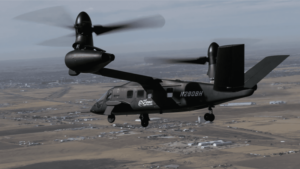The Army is seeking information from industry on potential mission equipment solutions for its Future Long Range Assault Aircraft (FLRAA), to include sensor systems, communication tools and pilot interfaces.
A new Request for Information published on Sept. 5 emphasizes the Army’s interest in software-based applications and technologies utilizing Modular Open Systems Architecture (MOSA) approaches to allow for rapid upgrades on FLRAA, the future UH-60 Black Hawk replacement.

“[The FLRAA program office] is specifically seeking information on the current state of technology and technology maturation through fiscal year 2030,” the Army writes in the new RFI. “The maturation roadmaps shall indicate Technology Readiness Level, Manufacturing Readiness Level and Integration Readiness Level to support FLRAA Increment 2 development/integration/delivery.”
Bell’s [TXT] V-280 Valor tiltrotor design was named the winner of the FLRAA competition last December, beating out a Sikorsky [LMT] and Boeing [BA] team’s Defiant X coaxial rigid rotor helicopter offering (Defense Daily, Dec. 5).
The Army’s initial FLRAA deal to Bell is worth up to $1.3 billion but could total $7 billion if all options are picked up.
Bell has selected GE Aerospace [GE] to develop the “Common Open Architecture Digital Backbone” for FLRAA (Defense Daily, Sept. 7).
“This is a foundational effort to improve weapon system capability and affordability for the Army by ensuring architectural alignment for integration of new technology,” Ryan Ehinger, Bell’s senior vice president and program director for FLRAA, said in a statement this week. “This collaborative approach provides the Army a vendor-agnostic path to explore new systems and capabilities – delivering soldiers the right tools for success in multi-domain missions.”
The Army details a range of mission systems of interest for FLRAA in the new RFI, to include sensors for obstacle detection, weather penetration, terrain avoidance and situational awareness as well as “multipurpose sensors capable of reducing the overall number of hardware solutions externally mounted on the aircraft without loss in capabilities.”
For communications tools, the RFI cites the Army’s interest in “multi- and single-band, software-defined radio systems and network communication sets capable of providing line of sight and beyond line of sight communication.”
The RFI also covers identification capabilities, with an emphasis on reduced size, weight and power and cost, as well as navigation solutions and software applications that can support platform supervised autonomy.
The Army is also interested in mission processing systems that “bring more computing power yet also enable MOSA for future growth/expandability,” according to the RFI.
On relevant software applications under the RFI, the Army notes it would seek systems that can “provide fused database and sensor data to cockpit displays or head up displays agnostic of hardware through an integrated modular avionics environment.”
For pilot interface capabilities, the Army is seeking information on solutions for cockpit displays, head-up displays, helmet-mounted displays “with a focus on binocular displays” as well as artificial intelligence, machine learning and voice activation technology.
“Solutions should reduce pilot workload and support autonomous functions (e.g. voice command functions, advanced teaming workload reduction, etc.),” the Army writes in the RFI.
Army officials have previously said the plan is to have Bell deliver the first physical prototypes for FLRAA in 2025, with continued digital design and work on the virtual prototype in the near-term as the program moves toward a Milestone B decision likely in the third quarter of fiscal year 2024 (Defense Daily, May 1).